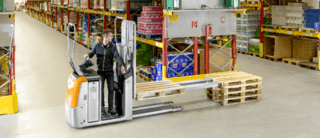10 mistakes you may be making when using your forklift truck

Driving a forklift truck requires a lot of know-how and good reflexes. Indeed, driving a forklift involves real risks. Every year, there are about 8,300 operator accidents with serious work injuries.
But why is this? Most of the time, accidents can be avoided with good driving disciplines and respect for safety rules. A transparent and well thought out traffic plan on site will also help reduce accidents.
But are you really up to date on all the rules to be observed when driving a forklift truck? To find out, check that you don't make one of these 10 common mistakes:
1. Driving in reverse using the rear-view mirrors
One of the most important things to know is that the mirrors are not designed for reversing. They are a particularly useful aid when manoeuvring. Remember that when driving in reverse i.e. when visibility from the front is reduced by a bulky load, you must look directly behind you.
2. Not checking the weight of the pallet before lifting it
Getting into the habit of handling the same load size or using the same forklift truck all the time is bad practice. This is because the chosen truck is not always necessarily the correct machine for the weight of the load. Make sure that you only lift and move loads that are suitable for your forklift truck. To do this, simply refer to the load data plate which can be found on the forklift.
3. Not wearing your seatbelt
Even on short journeys, there is a risk of overturning. Forklift truck manufacturers are required by law to fit a restraint system. The seatbelt is not the only restraint system available, however it helps to prevent fatal accidents in rollovers (driver held inside the passenger compartment without the risk of being crushed). So fasten your seatbelt as soon as you are ready to operate your forklift!
4. Charging the battery without wearing Personal Protective Equipment (PPE).
Recharging batteries is subject to many rules: It must be carried out by suitably trained personnel, in a well ventilated area. If possible a specific area should be set aside for this purpose. No metal tooling is to be placed on the battery. No smoking (release of hydrogen during charging = risk of explosion). Remove rings, watches and jewellery...but above all, the wearing of PPE is mandatory for protection. Including glasses and gloves.
5. Not reporting a fault to your site manager/team leader!
When you take over or at the end of a shift, you may notice a fault with the equipment that you are using: water, fuel, oil leak, etc. It is essential to report this fault to your site manager/team leader, in order to have the equipment repaired as quickly as possible. This will ensure that the equipment is safe to use by yourself and others.
6. Not adjusting your seat / drivers’ seating position
Most forklift trucks now have driving positions that can be adjusted to each individual. In particular the seat (which can move forwards or backwards depending on the length of the legs, and adapt in weight and possibly height). Also the steering wheel may be adjusted (inclination and depth). Taking a minute to properly adjust your position will reduce the risk of MSDs (Musculoskeletal Disorders) and fatigue at the end of your day / shift. Think about it...your work will be more enjoyable if you are comfortable.
7. Driving with the forks at height
Another common mistake, which affects the safety of everyone in the warehouse, is the position of the forks. Whatever the load (empty or not), it is essential to raise the forks to about 6 inches from the ground when driving. This will reduce the risk of the load tipping and/or falling. Driving with the load at height causes a shift in the machine's centre of gravity, which reduces its stability.
Furthermore, driving with the forks raised increases the risk of hitting a building structure or causing a collision.
8. Turning the wheels on a slope or ramp
It is especially important to be careful when driving on slopes or ramps. In particular, it is essential not to turn the steering and cause the truck to traverse the incline. This will reduce the risk of the forklift tipping or overturning.
9. Driving on a slope with the load facing down
One of the golden rules of forklift traffic is when driving on inclines. Care must be taken to drive with the load facing up the slope:
- When driving uphill, you must drive facing forward.
- When driving downhill, it is safer to drive in reverse.
10. Not adapting your driving if special equipment is fitted to the forklift
If any special or optional equipment is fitted to your truck, your manufacturer must provide you with an up-to-date load sheet and special recommendations on how to operate and adapt your driving. This is because the stability of the truck may be affected.
Comments
No comments
Subscribe to our blog!
As soon as a new article is published, we will notify you! You can unsubscribe at anytime.

Leave a comment